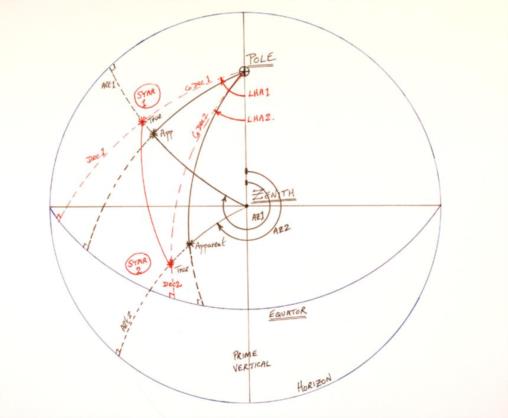
NavList:
A Community Devoted to the Preservation and Practice of Celestial Navigation and Other Methods of Traditional Wayfinding
From: Douglas Denny
Date: 2010 Mar 10, 04:51 -0800
I really shouldn't try to work complicated things out in my head and opening the mouth at the same time, especially late at night. It certainly confuses me if no one else. :-)
To probably confuse things more I have drawn a zenith diagram (see diagram) of what I think is the rigorous solution to this two star problem.
I look forward to George's critique as I accept his expert knowledge on this subject. Please do find flaws and point them out if I have missed something.
I did this exercise a very long time ago for the fun of it, and now I am having to re-visit it having forgotten how I did it last time.
---------
The refraction affects measured altitude and hence zenith distance which is what is effectively measured with a sextant.
Refraction is always subtracted as the true star position is always below the apparent in altitude. Hence between two stars there is a slight increase in the true distance between them as opposed to the measured. (see diagram).
Unlike the Lunar Distance case where we do not have local hour angle information, (which is what we want)- here we have the luxury of both Lat and Long and accurately timed sights, so LHA is known for both stars when sighted and the co-Lat of the observer.
So the procedure for a rigorous solution to the general case would be:-
Knowing LHAs for the two stars and knowing the declinations we can find Azimuth1 and Azimuth2 accurately by spherical trig. For example in the case of star2: co-dec2 is known; LHA2 is known, co-Lat is known, and true zenith distance when refraction is subtracted from the altitude: so Az2 can be accurately found for the true star.
Same applies for star1.
Now we have spherical triangle centred on the zenith: star1, star2, Zenith. and the included angle by subtraction of the azimuths.
We can now find the accurate star1 to star2 distance by spherical trig.
Douglas Denny.
Chichester. England.
----------------------------------------------------------------
NavList message boards and member settings: www.fer3.com/NavList
Members may optionally receive posts by email.
To cancel email delivery, send a message to NoMail[at]fer3.com
----------------------------------------------------------------







